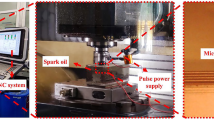Abstract
It is very significant to improve the diameter accuracy of micro-shafts fabricated by micro-electrical discharge machining (micro-EDM) in micro-tools application. The diameter accuracy includes the uniformity of a single micro-shaft in axial direction and the repeatability of micro-shafts with the same diameter. A newly proposed method, named twin-mirroring-wire tangential feed electrical discharge grinding (TMTF-WEDG), can realize high uniformity and repeatability of micro-shafts via tangentially feeding and constraining of a narrow slit formed by a twin-mirroring-wire on the diameter of micro-shafts, respectively. Controlling the material removal thickness in single-step machining of micro-shafts is necessary to achieve high uniformity and repeatability. This paper focuses on the effects of the several important factors on the material removal thickness of micro-shafts to reveal the effects on the diameter uniformity and repeatability, including the open voltage, capacitance, feed rate in the Z-direction, feed step in the Y-direction, and tangential feed distance. The results indicate that the lower open voltage or the smaller capacitance or higher Z-direction feed rate, the smaller the thickness of the material removed, which is advantageous for controlling the consistency and repeatability of the micro-shafts. Decreasing of Y-direction feed step from 20 to 5 μm is accompanied by a reduction in material removal thickness, and the material removal thickness of less than 0.4 μm is achieved with a smaller feed step of in the Y-direction. As the tangential feed distance S2 decreases, the material removal thickness of the micro-shafts decreases gradually. In this study, the uniformity and repeatability of brass and tungsten micro-shafts are controlled within 1 μm and 2 μm, respectively.




















Similar content being viewed by others
References
Qin Y (2010) Micromanufacturing engineering and technology. William Andrew, Oxford
Qin Y, Brockett A, Ma Y, Razali A, Zhao J, Harrison C, Pan W, Dai X, Loziak D (2010) Micro-manufacturing: research, technology outcomes and development issues. Int J Adv Manuf Technol 47(9–12):821–837
Tong H, Li Y, Zhang L, Li B (2013) Mechanism design and process control of micro EDM for drilling spray holes of diesel injector nozzles. Precis Eng 37(1):213–221
Chern GL, Wu YJE, Cheng JC, Yao JC (2007) Study on burr formation in micro-machining using micro-tools fabricated by micro-EDM. Precis Eng 31(2):122–129
Masuzawa T, Tönshoff HK (1997) Three-dimensional micromachining by machine tools. CIRP Ann 46(2):621–628
Li Z, Bai J, Tang J (2018) Micro-EDM method to fabricate three-dimensional surface textures used as SERS-active substrate. Appl Surf Sci 458:810–818
Asad A, Masaki T, Rahman M, Lim HS, Wong YS (2007) Tool-based micro-machining. J Mater Process Technol 192:204–211
Hourmand M, Sarhan AA, Sayuti M (2017) Micro-electrode fabrication processes for micro-EDM drilling and milling: a state-of-the-art review. Int J Adv Manuf Technol 91(1–4):1023–1056
Zhao WS, Jia BX, Wang ZL, Hu FQ (2006) Study on block electrode discharge grinding of micro rods. Key Eng Mater 304:201–205
Mohri N, Takayuki (2006) Micro-pin electrodes formation by micro-scanning EDM Process. CIRP Ann Manuf Technol 55(01):175–178
Qingfeng Y, Xingqiao W, Ping W, Zhiqiang Q, Lin Z, Yongbin Z (2016) Fabrication of micro rod electrode by electrical discharge grinding using two block electrodes. J Mater Process Technol 234:143–149
Masuzawa T, Fujino M, Kobayashi K, Suzuki T, Kinoshita N (1985) Wire electro-discharge grinding for micro-machining. CIRP Ann Manuf Technol 34(1):431–434
Sheu D Y (2011) Gradation twin-wire EDM manufacturing system: U.S. Patent 7,906,743
Sheu DY (2010) Microelectrode tools manufacturing by hybrid circuits twin-wire electro discharge grinding. Mater Manuf Process 25(10):1142–1147
Wang YQ, Bai JC (2014) Diameter control of micro shafts in wire electrical discharge grinding. Int J Adv Manuf Technol 72(9–12):1747–1757
Zhang L, Tong H, Li Y (2015) Precision machining of micro tool electrodes in micro EDM for drilling array micro holes. Precis Eng 39:100–106
Li Z, Bai J, Cao Y, Wang Y, Zhu G (2019) Fabrication of microelectrode with large aspect ratio and precision machining of micro-hole array by micro-EDM. J Mater Process Technol 268:70–79
Parthiban M, Krishnaraj V, Kanchana J, Babu MK (2018) Optimization of material removal rate in wire electric discharge grinding for micro machining of tungsten electrodes. Indian J Eng Mater Sci 25:307–314
Mehfuz R, Ali MY (2009) Investigation of machining parameters for the multiple-response optimization of micro electrodischarge milling. Int J Adv Manuf Technol 43(3–4):264–275
Yang RT, Tzeng CJ, Yang YK, Hsieh MH (2012) Optimization of wire electrical discharge machining process parameters for cutting tungsten. Int J Adv Manuf Technol 60(1–4):135–147
Ali MY, Rahman MA, Nordin R (2017) Micro wire electro discharge grinding: optimization of material removal rate and surface roughness. In IOP conference series. Mater Sci Eng 184(1):012032
Rees A, Brousseau E, Dimov SS, Bigot S, Griffiths CA (2013) Development of surface roughness optimisation and prediction for the process of wire electro-discharge grinding. Int J Adv Manuf Technol 64(9–12):1395–1410
Rees A, Dimov SS, Ivanov A, Herrero A, Uriarte LG (2007) Micro-electrode discharge machining: factors affecting the quality of electrodes produced on the machine through the process of wire electro-discharge machining. Proc Inst Mech Eng B J Eng Manuf 221(3):409–418
Yanqing Wang, Jianyu Jia, Zan Li, Shengqiang Yang, Jun Qian, Dominiek Reynaerts. Fabrication of micro-shafts by twin-mirroring-wire tangential feed micro electrical discharge grinding, unpublished results
Acknowledgments
This research is supported by the National Nature Science Foundation of China (Grant No. 51605323) and the Key Research and Development Program of Shanxi Province (Grant No. 201703D121006).
Author information
Authors and Affiliations
Corresponding authors
Additional information
Publisher’s note
Springer Nature remains neutral with regard to jurisdictional claims in published maps and institutional affiliations.
Rights and permissions
About this article
Cite this article
Jia, JY., Wang, YQ., Yang, SQ. et al. Study of the effects of important factors on the diameter accuracy of micro-shafts fabricated by TMTF-WEDG. Int J Adv Manuf Technol 108, 3001–3020 (2020). https://doi.org/10.1007/s00170-020-05412-9
Received:
Accepted:
Published:
Issue Date:
DOI: https://doi.org/10.1007/s00170-020-05412-9



